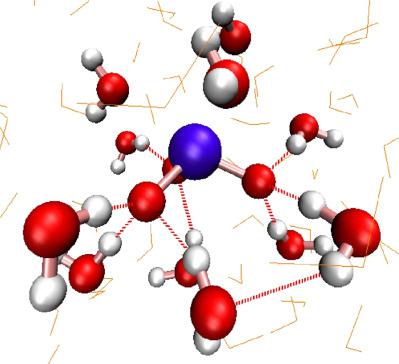当前位置:
X-MOL 学术
›
J. Comput. Chem.
›
论文详情
Our official English website, www.x-mol.net, welcomes your
feedback! (Note: you will need to create a separate account there.)
Nature of hydration shells of a polyoxy-anion with a large cationic centre: The case of iodate ion in water
Journal of Computational Chemistry ( IF 3.4 ) Pub Date : 2018-02-15 , DOI: 10.1002/jcc.25185 Bikramjit Sharma 1 , Amalendu Chandra 1
Journal of Computational Chemistry ( IF 3.4 ) Pub Date : 2018-02-15 , DOI: 10.1002/jcc.25185 Bikramjit Sharma 1 , Amalendu Chandra 1
Affiliation

|
The structural nature of the solvation shells of an iodate ion, which is known to be a polyoxy‐anion with a large cationic centre, is investigated by means of Born–Oppenheimer molecular dynamics (BOMD) simulations using BLYP and the dispersion corrected BLYP‐D3 functionals. The iodate ion is found to have two distinct solvation regions around the positively charged iodine (iodine solvation shell or ISS) and the negatively charged oxygens (oxygen solvation shell or OSS). We have looked at the spatial, orientational, and hydrogen bond distributions of water in the two solvation regions. It is found that the water orientational profile in the ISS is typical of a cation hydration shell. The hydrogen bonded structure of water in the OSS is found to be very similar to that of the bulk water structure. Thus, the iodate ion essentially behaves like a positively charged iodine ion in water as if there is no anionic part. This explains why the cationic character of the iodate ion was prominently seen in earlier studies. The arrangement of water molecules in the two solvation shells and in the intervening regions around the iodate ion is further resolved by looking at structural cross‐correlations. The electronic properties of the solvation shells are also looked at by calculating the solute–solvent orbital overlap and dipole moments of the solute and solvation shell water. We have also performed BOMD simulations of iodate ion‐water clusters at experimentally relevant conditions. The simulation results are found to be in agreement with experimental results. © 2018 Wiley Periodicals, Inc.
中文翻译:

具有大阳离子中心的聚氧阴离子水合壳的性质:水中碘酸根离子的情况
通过使用 BLYP 和色散校正的 BLYP-D3 的 Born-Oppenheimer 分子动力学 (BOMD) 模拟研究碘酸根离子的溶剂化壳的结构性质,该离子是具有大阳离子中心的聚氧阴离子泛函。发现碘酸根离子在带正电的碘(碘溶剂化壳或 ISS)和带负电的氧(氧溶剂化壳或 OSS)周围有两个不同的溶剂化区域。我们已经研究了两个溶剂化区域中水的空间、取向和氢键分布。发现国际空间站中的水取向剖面是典型的阳离子水合壳。发现 OSS 中水的氢键结构与本体水结构的氢键结构非常相似。因此,碘酸根离子基本上表现为水中带正电的碘离子,就好像没有阴离子部分一样。这解释了为什么碘酸盐离子的阳离子特征在早期研究中突出。通过观察结构互相关,可以进一步解析两个溶剂化壳层和碘酸根离子周围区域中水分子的排列。通过计算溶质和溶剂化壳水的溶质 - 溶剂轨道重叠和偶极矩,还可以查看溶剂化壳的电子特性。我们还在实验相关条件下对碘酸盐离子-水簇进行了 BOMD 模拟。发现模拟结果与实验结果一致。© 2018 Wiley Periodicals, Inc. 这解释了为什么碘酸盐离子的阳离子特征在早期研究中突出。通过观察结构互相关,可以进一步解析两个溶剂化壳层和碘酸根离子周围区域中水分子的排列。通过计算溶质和溶剂化壳水的溶质 - 溶剂轨道重叠和偶极矩,还可以查看溶剂化壳的电子特性。我们还在实验相关条件下对碘酸盐离子-水簇进行了 BOMD 模拟。发现模拟结果与实验结果一致。© 2018 Wiley Periodicals, Inc. 这解释了为什么碘酸盐离子的阳离子特征在早期研究中突出。通过观察结构互相关,可以进一步解析两个溶剂化壳层和碘酸根离子周围区域中水分子的排列。通过计算溶质和溶剂化壳水的溶质 - 溶剂轨道重叠和偶极矩,还可以查看溶剂化壳的电子特性。我们还在实验相关条件下对碘酸盐离子-水簇进行了 BOMD 模拟。发现模拟结果与实验结果一致。© 2018 Wiley Periodicals, Inc. 通过观察结构互相关,可以进一步解析两个溶剂化壳层和碘酸根离子周围区域中水分子的排列。通过计算溶质和溶剂化壳水的溶质 - 溶剂轨道重叠和偶极矩,还可以查看溶剂化壳的电子特性。我们还在实验相关条件下对碘酸盐离子-水簇进行了 BOMD 模拟。发现模拟结果与实验结果一致。© 2018 Wiley Periodicals, Inc. 通过观察结构互相关,可以进一步解析两个溶剂化壳层和碘酸根离子周围区域中水分子的排列。通过计算溶质和溶剂化壳水的溶质 - 溶剂轨道重叠和偶极矩,还可以查看溶剂化壳的电子特性。我们还在实验相关条件下对碘酸盐离子-水簇进行了 BOMD 模拟。发现模拟结果与实验结果一致。© 2018 Wiley Periodicals, Inc. 我们还在实验相关条件下对碘酸盐离子-水簇进行了 BOMD 模拟。发现模拟结果与实验结果一致。© 2018 Wiley Periodicals, Inc. 我们还在实验相关条件下对碘酸盐离子-水簇进行了 BOMD 模拟。发现模拟结果与实验结果一致。© 2018 Wiley Periodicals, Inc.
更新日期:2018-02-15
中文翻译:

具有大阳离子中心的聚氧阴离子水合壳的性质:水中碘酸根离子的情况
通过使用 BLYP 和色散校正的 BLYP-D3 的 Born-Oppenheimer 分子动力学 (BOMD) 模拟研究碘酸根离子的溶剂化壳的结构性质,该离子是具有大阳离子中心的聚氧阴离子泛函。发现碘酸根离子在带正电的碘(碘溶剂化壳或 ISS)和带负电的氧(氧溶剂化壳或 OSS)周围有两个不同的溶剂化区域。我们已经研究了两个溶剂化区域中水的空间、取向和氢键分布。发现国际空间站中的水取向剖面是典型的阳离子水合壳。发现 OSS 中水的氢键结构与本体水结构的氢键结构非常相似。因此,碘酸根离子基本上表现为水中带正电的碘离子,就好像没有阴离子部分一样。这解释了为什么碘酸盐离子的阳离子特征在早期研究中突出。通过观察结构互相关,可以进一步解析两个溶剂化壳层和碘酸根离子周围区域中水分子的排列。通过计算溶质和溶剂化壳水的溶质 - 溶剂轨道重叠和偶极矩,还可以查看溶剂化壳的电子特性。我们还在实验相关条件下对碘酸盐离子-水簇进行了 BOMD 模拟。发现模拟结果与实验结果一致。© 2018 Wiley Periodicals, Inc. 这解释了为什么碘酸盐离子的阳离子特征在早期研究中突出。通过观察结构互相关,可以进一步解析两个溶剂化壳层和碘酸根离子周围区域中水分子的排列。通过计算溶质和溶剂化壳水的溶质 - 溶剂轨道重叠和偶极矩,还可以查看溶剂化壳的电子特性。我们还在实验相关条件下对碘酸盐离子-水簇进行了 BOMD 模拟。发现模拟结果与实验结果一致。© 2018 Wiley Periodicals, Inc. 这解释了为什么碘酸盐离子的阳离子特征在早期研究中突出。通过观察结构互相关,可以进一步解析两个溶剂化壳层和碘酸根离子周围区域中水分子的排列。通过计算溶质和溶剂化壳水的溶质 - 溶剂轨道重叠和偶极矩,还可以查看溶剂化壳的电子特性。我们还在实验相关条件下对碘酸盐离子-水簇进行了 BOMD 模拟。发现模拟结果与实验结果一致。© 2018 Wiley Periodicals, Inc. 通过观察结构互相关,可以进一步解析两个溶剂化壳层和碘酸根离子周围区域中水分子的排列。通过计算溶质和溶剂化壳水的溶质 - 溶剂轨道重叠和偶极矩,还可以查看溶剂化壳的电子特性。我们还在实验相关条件下对碘酸盐离子-水簇进行了 BOMD 模拟。发现模拟结果与实验结果一致。© 2018 Wiley Periodicals, Inc. 通过观察结构互相关,可以进一步解析两个溶剂化壳层和碘酸根离子周围区域中水分子的排列。通过计算溶质和溶剂化壳水的溶质 - 溶剂轨道重叠和偶极矩,还可以查看溶剂化壳的电子特性。我们还在实验相关条件下对碘酸盐离子-水簇进行了 BOMD 模拟。发现模拟结果与实验结果一致。© 2018 Wiley Periodicals, Inc. 我们还在实验相关条件下对碘酸盐离子-水簇进行了 BOMD 模拟。发现模拟结果与实验结果一致。© 2018 Wiley Periodicals, Inc. 我们还在实验相关条件下对碘酸盐离子-水簇进行了 BOMD 模拟。发现模拟结果与实验结果一致。© 2018 Wiley Periodicals, Inc.











































 京公网安备 11010802027423号
京公网安备 11010802027423号